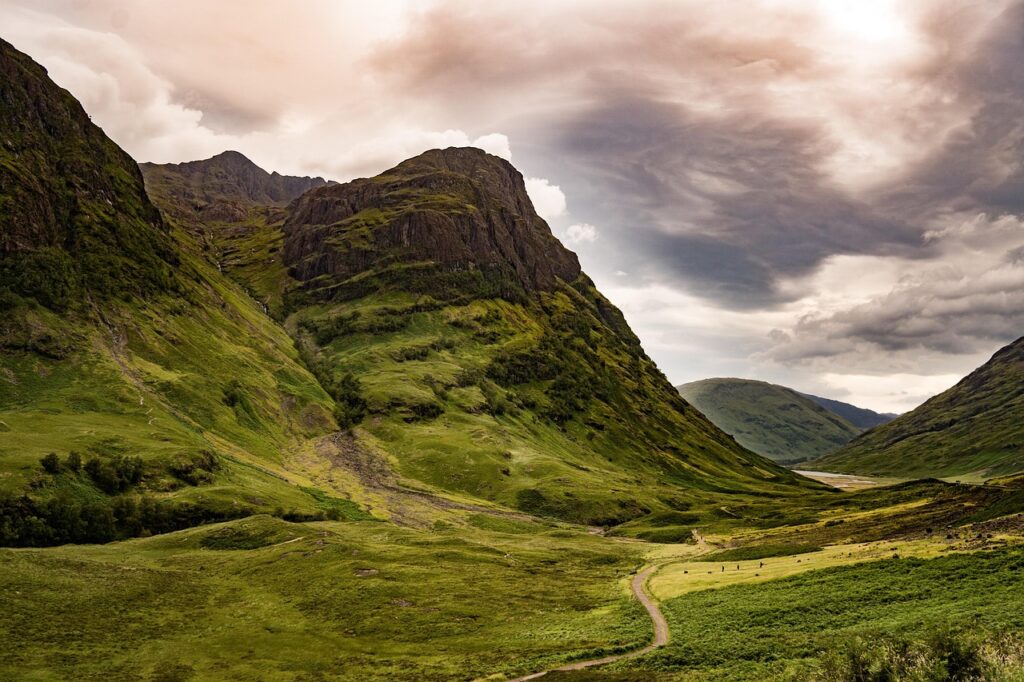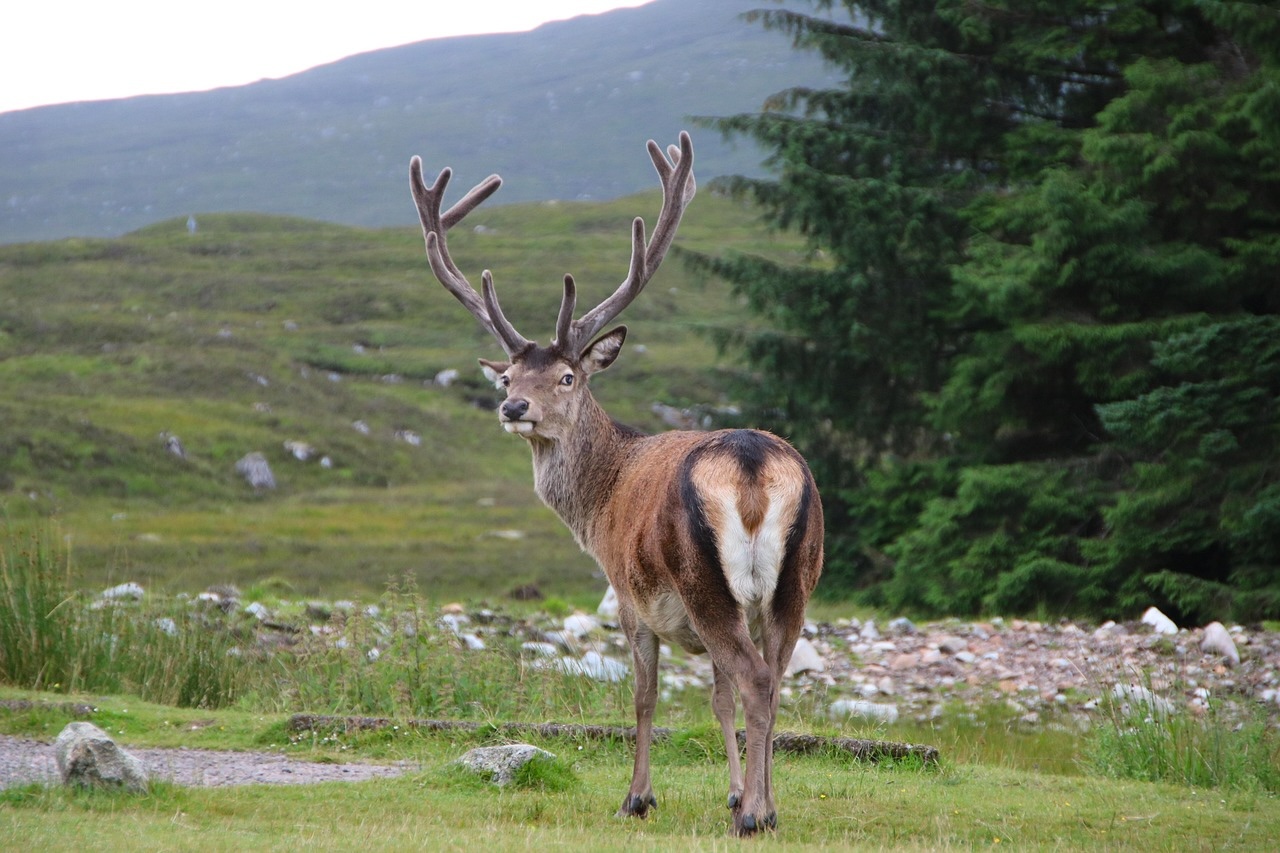The Scottish Highlands. The very name evokes images of wild, untamed beauty, of towering peaks and shimmering lochs, of ancient myths and fierce clans.
It’s an enchanting landscape where the air itself hums with stories carried on the wind. For the discerning traveler, it offers not just unparalleled vistas but a profound journey into history, a tangible connection to events that shaped a nation.
In the heart of this majestic wilderness lies Glencoe, a valley of such breathtaking grandeur that it feels almost divine. Yet, it holds within its dramatic folds a chilling tale of ancient betrayal that continues to whisper through the ages.
Driving into Glencoe is like entering a cathedral of stone and sky. The mountains, colossal and ancient, rise on either side, their craggy summits often swathed in shifting veils of mist. Here stand the iconic peaks known as the Three Sisters of Glencoe — Gearr Aonach, Aonach Dubh, and Beinn Fhada — their majestic forms dominating the horizon. They are silent and enduring witnesses to the raw power of nature and the transient, yet deeply etched, dramas of humankind that have unfolded beneath their unwavering gaze.
As you traverse the winding roads, hike the exhilarating trails, and breathe the crisp mountain air, you can almost feel the weight of centuries settling upon you, preparing you for the profound story that awaits.
For Glencoe is not merely a scenic marvel; it is the setting for the infamous Massacre of Glencoe, an act of calculated treachery that remains a raw nerve in Scottish history. It’s a tale of hospitality violated, trust shattered, and lives brutally extinguished, leaving an indelible stain on the fabric of the Highlands.
The winter of 1692 was bitter. Scotland, still reeling from the political turmoil of the Jacobite uprisings, was under the new reign of King William III. A proclamation had been issued: all Highland clan chiefs must swear an oath of allegiance to the new monarchs by Jan. 1, 1692, or face severe consequences. The MacDonalds of Glencoe, a proud and fiercely independent clan with a long history of loyalty to the deposed Stuart kings, found themselves in a perilous position. Their chief, MacIain, delayed taking the oath, not out of defiance, but due to a complex web of circumstances and a treacherous journey through deep snows to reach the magistrate. He eventually took the oath on Jan. 6, days after the deadline.
Unknown to MacIain and his people, this slight delay was seized upon by political figures eager to make an example of the rebellious Highlanders. An order was issued, bearing the King’s signature, for the “extirpation” of the MacDonalds of Glencoe. The grim task was given to regiments, notably one led by Captain Robert Campbell of Glenlyon.
And here lies the heart of the tragedy, the profound depth of the betrayal that echoes through the glen. For nearly two weeks leading up to the massacre, Captain Campbell and his soldiers were billeted amongst the MacDonalds of Glencoe. They were welcomed into their homes, sharing food, drink, and the warmth of their hearths. The sacred Highland code of hospitality, a bedrock of their culture, was meticulously observed. The soldiers were treated not as occupiers, but as trusted guests. They played cards with the men, shared jokes, and ate meals prepared by the women, building a false sense of camaraderie.
Then, in the pre-dawn hours of Feb. 13, the unthinkable happened. At a pre-arranged signal, the Campbells turned on their unsuspecting hosts. Men were shot in their beds, women and children were killed as they fled into the blizzard-swept darkness. MacIain himself was among the first to fall. The chilling order explicitly stated, “You are hereby ordered to fall upon the Rebells, the McDonalds of Glenco, and putt all to the sword under Seventy.”
While not every MacDonald perished – many managed to escape into the unforgiving mountains, aided by the storm and the vastness of the glen – the massacre extinguished countless lives and shattered the community. The cries of the dying, the crack of muskets, and the desperate pleas for mercy mingled with the howling wind, creating a symphony of terror that, even now, seems to haunt the very air.
The historical context of the long-standing feud between the Campbells and the MacDonalds further intensifies the Glencoe tragedy. For centuries, these two powerful clans had been rivals, often clashing over land and vying for dominance. The Campbells, with their growing influence and often aligning themselves with the ruling powers, were viewed with suspicion and resentment by many other clans, especially the independent-minded MacDonalds. The Massacre of Glencoe, though primarily a government-orchestrated political act, was carried out by Campbell-led forces, cementing their image as instruments of royal will and, in the eyes of the Highlanders, as ruthless betrayers.

To this day, the legacy of Glencoe and the wider historical animosity between the Campbells and the MacDonalds runs deep within Scottish consciousness. While centuries have passed, and the direct violence is long over, the story is far from forgotten. You might still encounter expressions of this lingering sentiment, such as the famous (and often humorous) “No Campbells” signs found in some Highland pubs. These aren’t meant as literal threats, but rather as poignant, often ironic, reminders of a historical wound that, while healing, has never fully faded. It is a powerful testament to the enduring grip of these clan histories that an event from over three centuries ago continues to evoke strong feelings and forms a vital part of the Highland identity.
This deeply ingrained historical memory finds a startling parallel in popular culture. For many, the harrowing events of the Glencoe Massacre directly inspired one of the most shocking moments in modern fantasy: the Red Wedding in George R.R. Martin’s A Song of Ice and Fire series, famously depicted in HBO’s Game of Thrones.
In Game of Thrones, the Red Wedding is the shocking slaughter of Robb Stark, his mother Catelyn, and their allies by House Frey and House Bolton during a wedding feast at the Twins. Like the MacDonalds, the Starks are betrayed under the guise of hospitality. Lord Walder Frey, resentful of Robb’s broken marriage pact, lures the Starks to a celebration, only to unleash a massacre as the band plays “The Rains of Castamere.” Crossbows fire, throats are slit, and the Stark banners fall, leaving viewers stunned.
Martin has acknowledged the Glencoe Massacre as a key influence, alongside the Black Dinner of 1440, another Scottish betrayal. In interviews, he noted the power of such events to shock and shape narratives. “The violation of guest right,” he said, “is a taboo that resonates across cultures.” In Glencoe, the breach of Highland hospitality was a moral outrage; in Westeros, the breaking of guest right cursed the Freys. Both stories hinge on the betrayal of trust, the exploitation of ritual, and the slaughter of the unsuspecting.
Visiting Glencoe today, therefore, offers more than just stunning scenery and exhilarating hikes. It’s an opportunity for deep historical and emotional engagement. As you stand amidst the soaring peaks, perhaps by the dark waters of Loch Achtriochtan or tracing the paths of the Three Sisters, you can almost hear the echoes of the past – the laughter of families, the crack of muskets, the desperate cries for mercy, and the profound, enduring silence that followed. It’s a place that teaches you about the raw power of nature, the fierce loyalty of clans, the tragic consequences of political maneuvering, and the universal, timeless horror of betrayal.
The Scottish Highlands, with the haunting beauty and historical weight of Glencoe at its heart, invite you to not just see their magnificence, but to feel their stories, to walk in the footsteps of those who lived and died here, and to truly understand the enduring spirit of a land shaped by both breathtaking grandeur and profound human drama. It is a journey that stays with you, long after the mist has cleared and the mountains have faded from view, leaving you with a richer appreciation for the intricate tapestry of history, legend and landscape.




